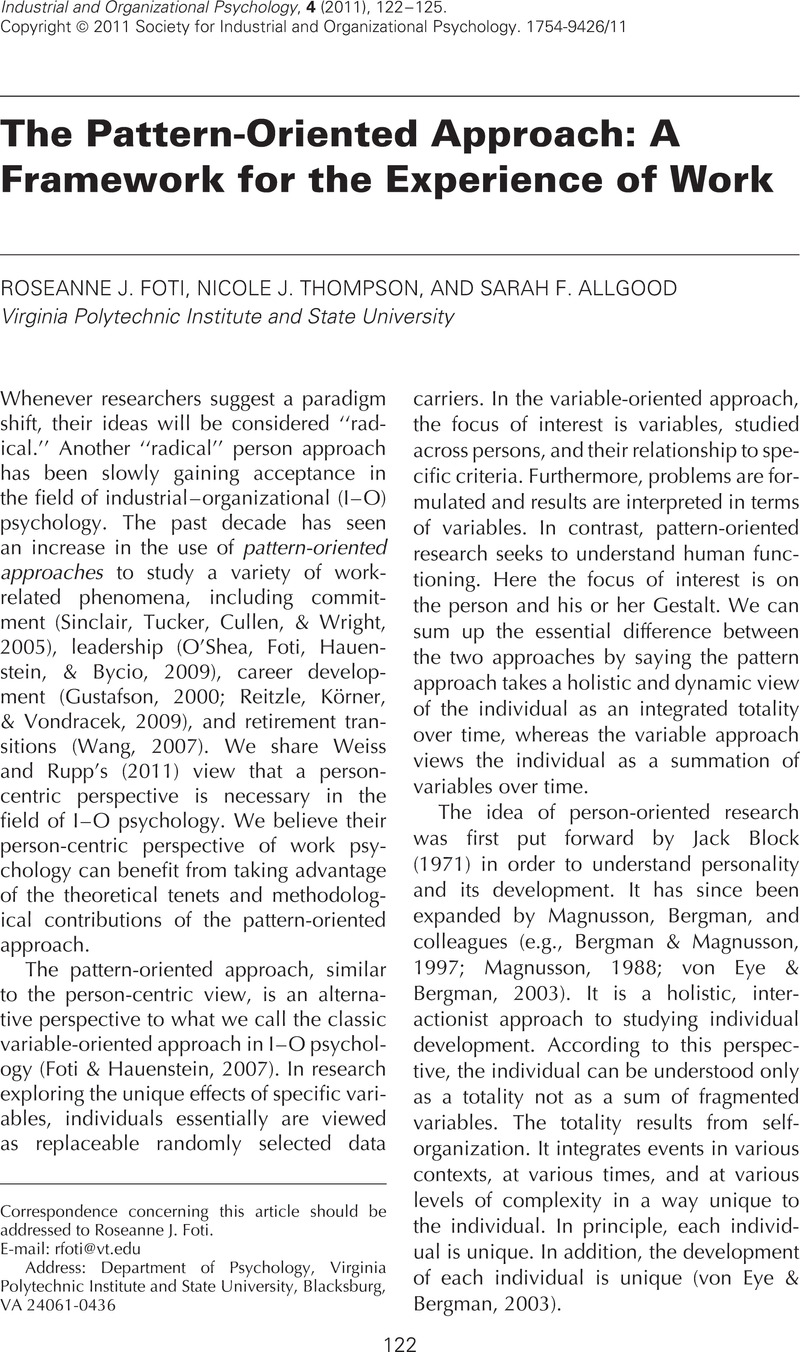Crossref Citations
This article has been cited by the following publications. This list is generated based on data provided by Crossref.
Weiss, Howard M.
and
Rupp, Deborah E.
2011.
Envisioning a Person-Centric Work Psychology.
Industrial and Organizational Psychology,
Vol. 4,
Issue. 1,
p.
138.
Vinkenburg, Claartje J.
and
Weber, Torsten
2012.
Managerial career patterns: A review of the empirical evidence.
Journal of Vocational Behavior,
Vol. 80,
Issue. 3,
p.
592.
Obschonka, Martin
Silbereisen, Rainer K.
and
Wasilewski, Jacek
2012.
Constellations of new demands concerning careers and jobs: Results from a two-country study on social and economic change.
Journal of Vocational Behavior,
Vol. 80,
Issue. 1,
p.
211.
Woo, Sang Eun
and
Allen, David G.
2014.
Toward an Inductive Theory of Stayers and Seekers in the Organization.
Journal of Business and Psychology,
Vol. 29,
Issue. 4,
p.
683.
MacDougall, Alexandra E.
Baur, John E.
Novicevic, Milorad M.
and
Buckley, M. Ronald
2014.
Research in Personnel and Human Resources Management.
Vol. 32,
Issue. ,
p.
177.
Lisak, Alon
and
Erez, Miriam
2015.
Leadership emergence in multicultural teams: The power of global characteristics.
Journal of World Business,
Vol. 50,
Issue. 1,
p.
3.
Bogat, G. Anne
von Eye, Alexander
and
Bergman, Lars R.
2016.
Developmental Psychopathology.
p.
1.
Conte, Jeffrey M.
Heffner, Tonia S.
Roesch, Scott C.
and
Aasen, Bryan
2017.
A person-centric investigation of personality types, job performance, and attrition.
Personality and Individual Differences,
Vol. 104,
Issue. ,
p.
554.
Arnold, Kara A.
Connelly, Catherine E.
Gellatly, Ian R.
Walsh, Megan M.
and
Withey, Michael J.
2017.
Using a pattern‐oriented approach to study leaders: Implications for burnout and perceived role demand.
Journal of Organizational Behavior,
Vol. 38,
Issue. 7,
p.
1038.
Woo, Sang Eun
Jebb, Andrew T.
Tay, Louis
and
Parrigon, Scott
2018.
Putting the “Person” in the Center.
Organizational Research Methods,
Vol. 21,
Issue. 4,
p.
814.
Williams, Nathaniel J.
Frank, Hannah E.
Frederick, Lindsay
Beidas, Rinad S.
Mandell, David S.
Aarons, Gregory A.
Green, Philip
and
Locke, Jill
2019.
Organizational culture and climate profiles: relationships with fidelity to three evidence-based practices for autism in elementary schools.
Implementation Science,
Vol. 14,
Issue. 1,
Stadnick, Nicole A
Meza, Rosemary D
Suhrheinrich, Jessica
Aarons, Gregory A
Brookman-Frazee, Lauren
Lyon, Aaron R
Mandell, David S
and
Locke, Jill
2019.
Leadership profiles associated with the implementation of behavioral health evidence-based practices for autism spectrum disorder in schools.
Autism,
Vol. 23,
Issue. 8,
p.
1957.
Das Swain, Vedant
Saha, Koustuv
Rajvanshy, Hemang
Sirigiri, Anusha
Gregg, Julie M.
Lin, Suwen
Martinez, Gonzalo J.
Mattingly, Stephen M.
Mirjafari, Shayan
Mulukutla, Raghu
Nepal, Subigya
Nies, Kari
Reddy, Manikanta D.
Robles-Granda, Pablo
Campbell, Andrew T.
Chawla, Nitesh V.
D'Mello, Sidney
Dey, Anind K.
Jiang, Kaifeng
Liu, Qiang
Mark, Gloria
Moskal, Edward
Striegel, Aaron
Tay, Louis
Abowd, Gregory D.
and
De Choudhury, Munmun
2019.
A Multisensor Person-Centered Approach to Understand the Role of Daily Activities in Job Performance with Organizational Personas.
Proceedings of the ACM on Interactive, Mobile, Wearable and Ubiquitous Technologies,
Vol. 3,
Issue. 4,
p.
1.
Muhammad, Rabiah S.
Wolters, Heather M. K.
and
Jayne, Bradley S.
2020.
Personality testing: enhancing in-service selection of mid-career soldiers.
Military Psychology,
Vol. 32,
Issue. 1,
p.
71.
Williams, Nathaniel J.
Candon, Molly
Stewart, Rebecca E.
Byeon, Y. Vivian
Bewtra, Meenakshi
Buttenheim, Alison M.
Zentgraf, Kelly
Comeau, Carrie
Shoyinka, Sonsunmolu
and
Beidas, Rinad S.
2021.
Community stakeholder preferences for evidence-based practice implementation strategies in behavioral health: a best-worst scaling choice experiment.
BMC Psychiatry,
Vol. 21,
Issue. 1,
Biron, Caroline
Karanika-Murray, Maria
and
Ivers, Hans
2022.
The health-performance framework of presenteeism: A proof-of-concept study.
Frontiers in Psychology,
Vol. 13,
Issue. ,
Conte, Jeffrey M.
and
Harmata, Rebecca K.
2023.
Person-Centered Study of Cognitive Ability Dimensions Using Latent Profile Analysis.
Journal of Intelligence,
Vol. 11,
Issue. 5,
p.
80.
Meza, Rosemary D.
AlRasheed, Rashed
Pullmann, Michael D.
and
Dorsey, Shannon
2023.
Clinical supervision approach predicts evidence-based trauma treatment delivery in children’s mental health.
Frontiers in Psychiatry,
Vol. 13,
Issue. ,





